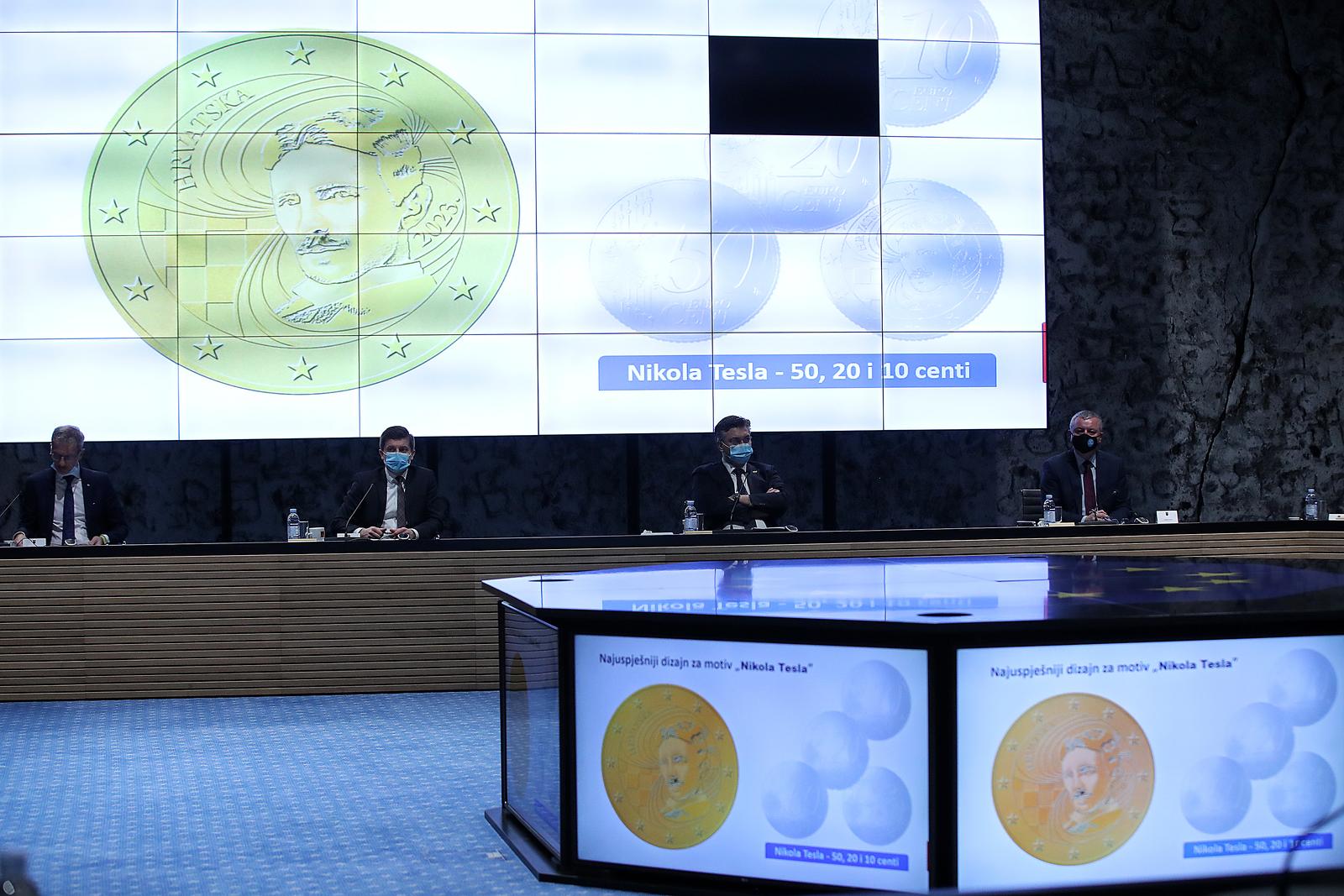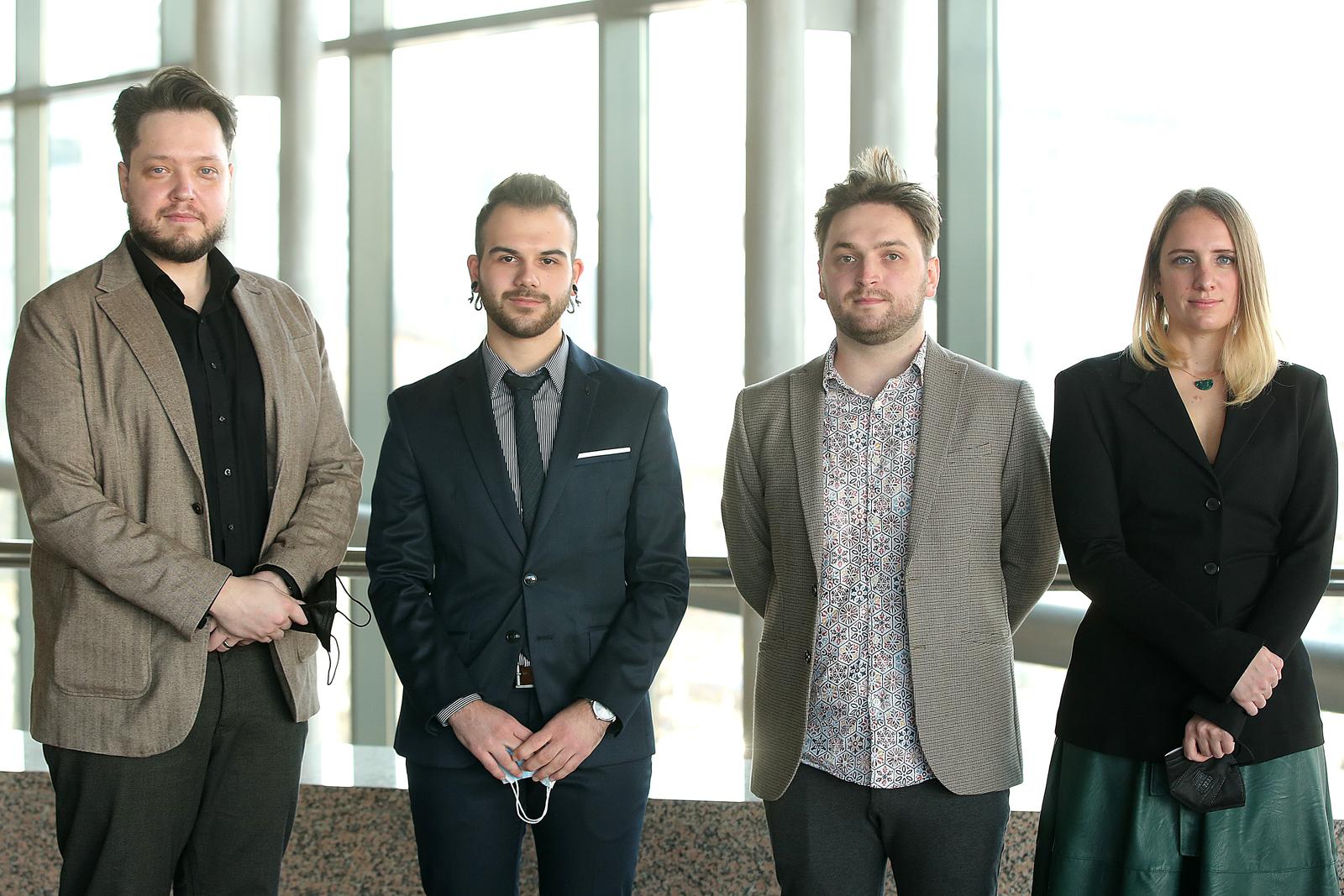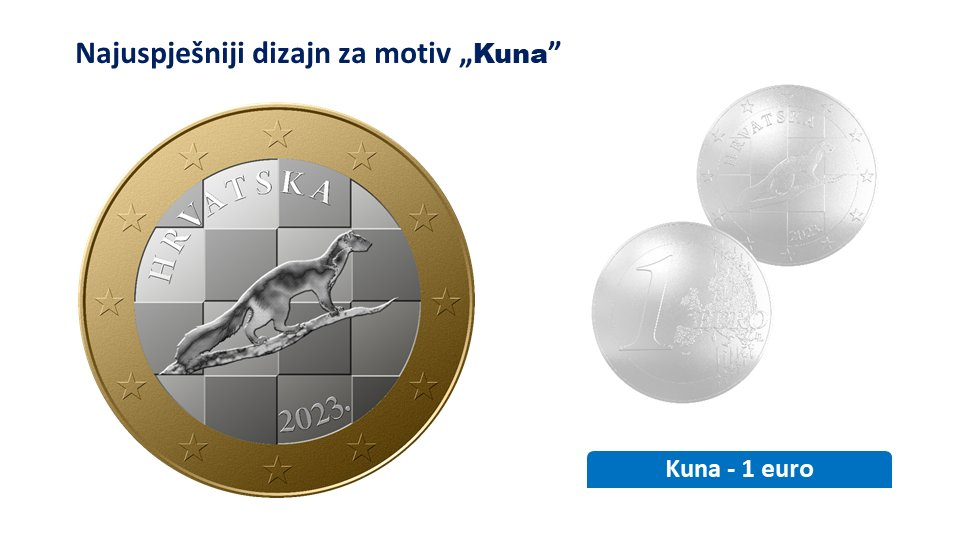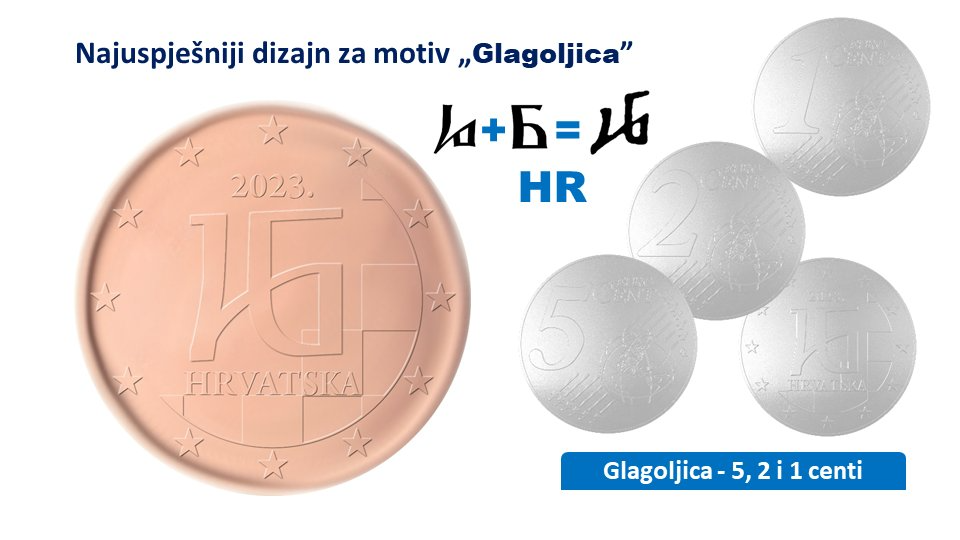Croatian Euro Coin Design Winners Officially Announced
February 4, 2022 - Through their official social media accounts, both the Prime Minister of the Republic of Croatia and the Croatian Government shared the winning motifs for the 2 and 1 Croatian euro coin, and the 50, 20, 10, 5, 2, and 1 cent coins, all of which will enter in circulation next year.
In recent years, the conversation around Croatia's accession to the eurozone has been increasing significantly. Since joining the European Union in mid-2013, the idea of carrying out a transition from the kuna to the euro has gone from being a distant scenario to near reality. It is no secret that the Croatian government's position on such change was favorable and that, eventually, it was simply a matter of defining how and when.
Precisely, as of today, the answers to both questions are already known, as the Croatian Government, its Ministry of Finance, and the Croatian National Bank (HNB) are working on the final details. The Croatian Kuna will cease to be the official currency, and the Euro will replace it in 2023. From September 5th, prices will be displayed in both Kuna and Euros, so that both locals and foreigners get used to the idea and become familiar with the new currency. Likewise, the first two months of 2023 will serve to withdraw the Kuna from circulation. As the Governor of the HNB Boris Vujčić reported shortly ago, citizens will have the possibility of paying with kunas, but only as a way to collect those coins for their subsequent storage.
Now that the idea of the euro as the official currency in Croatia is getting closer and closer to reality, many questions have arisen from both financial authorities, companies, and even Croatian citizens themselves. The positions are diverse: from rejecting the Euro in order to defend a Croatian symbol such as the Kuna, to wondering what the economic consequences will really be. The rejection of a large sector of the population was expressed through a referendum that was recently held throughout the country. The objective of the referendum was to postpone Croatia's access to the eurozone because, it should be remembered, by being a member of the European Union, Croatia cannot bail out of using the Euro as currency, but it could keep an indefinite period of transition.
The government responded by guaranteeing that not only will the transition from one currency to another take place smoothly, but that the long-term benefits will allow Croatia to reach economic standards that allow it to equalize its status with other European Union countries. Minister Zdravko Marić revealed that the Ministry of Finance will make sure to monitor that prices are set correctly, and does not rule out the existence of sanctions for those who increase them unsustainably. For its part, the Croatian National Bank promised to effectively control the inflation rates that may be generated as a result of this currency change.

Today's session of the National Council for the Introduction of the Euro as the Official Currency in Croatia. (Photo: Goran Stanzl/PIXSELL)
Most likely, doubts will be resolved along the way, since it seems that the decision has already been made and there is no going back. Following an official Croatian government meeting earlier today, the Government of the Republic of Croatia shared the official winner designs of the Croatian Euro coin, and all the details about each design, on their social media accounts. You can watch the complete session here. Each coin was accompanied by a video and information about its designers. The Government shared the following on their Instagram account:
''At today's session of the National Council for the Introduction of the Euro as the Official Currency in Croatia, the design solutions of the Croatian side of the euro and cent coins were presented. A total of 1,299 proposals were submitted to the open competition, and the commission in charge of selecting the most successful solutions did not know who the authors were, but evaluated and ranked each proposal only on the basis of the proposed design.
The first-ranked proposals were officially approved by European Council on January 28 this year. We also thank and congratulate the authors of the selected motifs! These are:
- Ivan Šivak - author of the conceptual design "Geographic Map of Croatia" for a 2 euro coin
Najuspješniji dizajn za motiv „Geografska karta Hrvatske" - kovanica 2 € pic.twitter.com/XSxLU3OTDI
— Vlada Republike Hrvatske (@VladaRH) February 4, 2022
The author of the 2 euro coin motif, "Geographical Map of Croatia", is Ivan Šivak, born in 1985 in Zagreb. He graduated from the Academy of Fine Arts in Zagreb in 2011 at the Department of Animated Film and New Media. Since 2011 he has been a member of the Croatian Society of Fine Artists. He lives and works in Samobor.
- Stjepan Pranjković - author of the conceptual design "Kuna" for a 1 euro coin
Najuspješniji dizajn za motiv „Kuna” - kovanica 1 € pic.twitter.com/CJwzWMcIqR
— Vlada Republike Hrvatske (@VladaRH) February 4, 2022
The author of the 1 euro coin motif, ''Kuna'', is Stjepan Pranjković, born in 1995 in Ostfildern, Germany. At the Academy of Applied Arts in Rijeka, majoring in Applied Arts, module painting, he obtained the title of Master of Applied Arts in 2020. He lives in Rijeka.
- Ivan Domagoj Račić - author of the conceptual design "Nikola Tesla" for 50, 20 and 10 cent coins
Najuspješniji dizajn za motiv „Nikola Tesla” - kovanice 50, 20 i 10 centi pic.twitter.com/sGfVnrTaCX
— Vlada Republike Hrvatske (@VladaRH) February 4, 2022
The author of the 50, 20, and 10 cent coin motif, ''Nikola Tesla, is Ivan Domagoj Račić, born in 1999 in Zagreb. Today he is a full-time third-year aeronautics student at the Faculty of Transport and Traffic Sciences in Zagreb. His interest in graphic design began in high school, when he began to study independently.
- Maja Škripelj - author of the conceptual design "Glagolitic" for coins of 5, 2 and 1 cent
Najuspješniji dizajn za motiv „Glagoljica” - kovanice 5, 2 i 1 cent pic.twitter.com/kh1IYEzSXV
— Vlada Republike Hrvatske (@VladaRH) February 4, 2022
The author of the 5, 2 and 1 cent coin motif, ''Glagolitic'', is Maja Škripelj, born in 1988 in Zagreb. She graduated from the Faculty of Architecture in Zagreb with a master's degree in engineering and architecture in February 2014. From graduation until July 2020, she worked in the architectural office, and now has her own business.

The designers behind the winning motifs for the Croatian euro coin: Ivan Šivak, Ivan Domagoj Račić, Stjepan Pranjković, and Maja Škripelj. (Photo: Goran Stanzl/PIXSELL)
After presenting the winners and their designs, the Croatian Government continued:
''In addition to the mentioned motifs, the Council of the European Union also approved another, additional motif, ie the text, which is an inscription that each country can choose and engrave on the 2 euro coin, which is the largest.
On the Croatian 2 euro coin, in addition to the Croatian chessboard, as an element of the Croatian coat of arms, and a map of the Republic of Croatia, Gundulić's verse "O LIJEPA O DRAGA O SLATKA SLOBODO" will be engraved on the rim.
As is well known, this is one of the most famous and beautiful verses from the Anthem of Freedom, which is an integral part of the pastoral "Dubravka" from the 17th century by Ivan Gundulić. The Republic of Croatia, as a symbol of Croatian statehood and independence, should also have a verse from the Anthem of Freedom, which best symbolizes the millennial aspiration for freedom of the Croatian people''.
Below we show you each Croatian euro coin in detail:

The Croatian Euro coin designed by Ivan Šivak features the geographical map of Croatia and due to its size also features the verse: ''O LIJEPA O DRAGA O SLATKA SLOBODO'' engraved on the edge.

The Croatian Euro coin designed by Stjepan Pranjković features the Kuna, Croatia's symbolic animal.

The Croatian Euro coin designed by Ivan Domagoj Račić features Nikola Tesla, the world-famous inventor and engineer born in Smiljan.

The Croatian Euro coin designed by Maja Škripelj features the Glagolitic alphabet, the oldest Slavic alphabet, from Croatia. The two Glagolitic letters chosen will form the Croatian ISO: HR.
For more, check out our politics section.
President: Euro Adoption Will Have More Pluses Than Minuses for Croatia
ZAGREB, 28 Oct 2021 - President Zoran Milanović said on Wednesday that Croatia would have more benefits than disadvantages from the euro adoption and that Malta could help Zagreb with its experience in the euro area.
Malta has been in the euro area since 1 January 2008, and today when Milanović met with his Maltese counterpart George Vella, he said that he believes that country can help Croatia with its experience.
"This is a country which has been inside for a long time, it has the experience and that experience is good," said Milanović and added that the Maltese economy is "exposed to the services sector and in particular to tourism," and has several common points with Croatia's economy.
"Our economy, unfortunately, or luckily, or just as a point - is not exceptionally export-orientated. We are a service-based economy and that is one of the reasons why I think the euro would be better for Croatia than it would be worse," said Milanović.
The president underscored that introducing the euro "isn't pittance" and that "it seems we will relinquish our national currency forever."
"That is not done with an excited heart, but with a sober head."
Milanović asked Malta to support Croatia, as the youngest EU member state, and its accession to the Schengen Area and criticized the Union for "procrastination and delay."
Romania and Bulgaria have been members of the EU since 2007 and are still waiting for a green light to access that area.
The time has already ripened for them to join the Schengen Area, however, political mainstream in the largest countries simply have a problem, which I understand, and that is the problem of right-wing voters hence they need "to tread on eggs cautiously," as the saying goes, he said.
For more, check out our politics section.
Croatian National Bank (HNB) Currency Committee Proposes Five Motifs For Euro Coins
ZAGREB, 21 July, 2021 - The Croatian coat-of-arms, a geographical map of Croatia, the marten (Croatian: kuna), the Glagolitic script and Nikola Tesla are motifs proposed for the Croatian side of euro coins, the Croatian National Bank (HNB) said on Wednesday.
The HNB Currency Committee today defined the final proposal for motifs for the national sides of future Croatian euro coins, which will now be considered by the National Council for the Introduction of the Euro as Official Currency in the Republic of Croatia, and then the government will adopt a conclusion.
The Croatian coat-of-arms will be used as a background on all coins, and other motifs will be used on coins of different denominations so that the 2 euro coin will feature a geographical map of Croatia, the 1 euro coin the marten, the 50, 20 and 10 cents coins Nikola Tesla, and 1, 2 and 5 cents coins the Glagolitic script.
The HNB said the main criteria for the selection was that the motif is acceptable to the general public and that it is a national symbol.
The rating given by citizens via an online survey at euro.hr, in which nearly 50,000 citizens took part, and a structured national survey on a sample of 1,000 citizens also influenced the Committee's final decision.
Based on the selected motifs, the HNB will announce a tender for the design of the national side of the euro coin. In mid October, the HNB will send the design of the motifs to the European Commission and the Council of the European Union, the press release said.
The production of euro coins with the Croatian national side should start at least six months before the introduction of the euro, that is the decision of the Council of the EU that Croatia is introducing the euro.
For more about politics in Croatia, follow TCN's dedicated page.
ECB Extends Currency Swap with HNB Until End of June 2021
ZAGREB, August 28, 2020 - The European Central Bank and the Croatian National Bank (HNB) have agreed to extend a euro liquidity line by six months until the end of June 2021, the HNB said on Friday.
The ECB and the HNB established a currency swap in April under which the HNB can borrow up to €2 billion from the ECB in exchange for Croatian kuna.
The swap was agreed to, to provide euro liquidity to Croatian financial institutions to address possible euro liquidity needs in the presence of market dysfunctions due to the COVID-19 shock. The euro liquidity line had been agreed initially until the end of 2020.
The maximum maturity for each drawing is three months.
For the latest travel info, bookmark our main travel info article, which is updated daily.
Read the Croatian Travel Update in your language - now available in 24 languages


